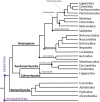The Adipokinetic Peptides of Hemiptera: Structure, Function, and Evolutionary Trends
- PMID: 38468778
- PMCID: PMC10926376
- DOI: 10.3389/finsc.2022.891615
The Adipokinetic Peptides of Hemiptera: Structure, Function, and Evolutionary Trends
Abstract
The Hemiptera comprise the most species-rich order of the hemimetabolous insects. Members of a number of superfamilies, most notably especially the more basal ones such as white flies, psyllids and aphids, belong to the most destructive agricultural insects known worldwide. At the other end of the phylogenetic tree are hemipterans that are notorious medical pests (e.g. kissing bugs). Most of the hemipteran species are good flyers, and lipid oxidation plays a pivotal role to power the contraction of flight muscles and, in aquatic water bugs, also deliver the ATP for the extensive swimming action of the leg muscles. Mobilization of stored lipids (mostly triacylglycerols in the fat body) to circulating diacylglycerols in the hemolymph is regulated by a set of small neuropeptides, the adipokinetic hormones (AKHs). We searched the literature and publicly available databases of transcriptomes and genomes to present here AKH sequences from 191 hemipteran species. Only few of these peptides were sequenced via Edman degradation or mass spectrometry, and even fewer were characterized with molecular biology methods; thus, the majority of the AKHs we have identified by bioinformatics are merely predicted sequences at this stage. Nonetheless, a total of 42 AKH primary sequences are assigned to Hemiptera. About 50% of these structures occur also in other insect orders, while the remaining 50% are currently unique for Hemiptera. We find 9 novel AKHs not shown to be synthesized before in any insect. Most of the hemipteran AKHs are octapeptides (28) but there is an impressive number of decapeptides (12) compared to other speciose orders such as Diptera and Lepidoptera. We attempt to construct a hypothetical molecular peptide evolution of hemipteran AKHs and find quite a bit of overlapping with current phylogenetic ideas of the Hemiptera. Lastly, we discuss the possibility to use the sequence of the aphid AKH as lead peptide for the research into a peptide mimetic fulfilling criteria of a green insecticide.
Keywords: AKH primary structure; Hemiptera; insect flight; lipid metabolism; molecular evolution of hemipteran AKHs; phylogeny of Hemiptera; regulation by adipokinetic hormone (AKH); true bugs.
Copyright © 2022 Gäde and Marco.
Conflict of interest statement
The authors declare that the research was conducted in the absence of any commercial or financial relationships that could be construed as a potential conflict of interest.
Figures


Similar articles
-
The African froghopper Ptyelus flavescens (suborder: Cicadomorpha) contains two novel and one known peptides of the adipokinetic hormone (AKH) family: structure, function and comparison with aphid AKH (suborder: Sternorrhyncha).Amino Acids. 2017 Oct;49(10):1679-1690. doi: 10.1007/s00726-017-2461-y. Epub 2017 Jul 14. Amino Acids. 2017. PMID: 28710552
-
Unique Members of the Adipokinetic Hormone Family in Butterflies and Moths (Insecta, Lepidoptera).Front Physiol. 2020 Dec 17;11:614552. doi: 10.3389/fphys.2020.614552. eCollection 2020. Front Physiol. 2020. PMID: 33391031 Free PMC article.
-
The Adipokinetic Peptides in Diptera: Structure, Function, and Evolutionary Trends.Front Endocrinol (Lausanne). 2020 Mar 31;11:153. doi: 10.3389/fendo.2020.00153. eCollection 2020. Front Endocrinol (Lausanne). 2020. PMID: 32296388 Free PMC article.
-
Cell biology of the adipokinetic hormone-producing neurosecretory cells in the locust corpus cardiacum.Microsc Res Tech. 2002 Feb 1;56(3):227-36. doi: 10.1002/jemt.10026. Microsc Res Tech. 2002. PMID: 11810724 Review.
-
New insights into adipokinetic hormone signaling.Mol Cell Endocrinol. 1998 Jun 25;141(1-2):7-12. doi: 10.1016/s0303-7207(98)00079-3. Mol Cell Endocrinol. 1998. PMID: 9723879 Review.
Cited by
-
Mass Spectrometric Proof of Predicted Peptides: Novel Adipokinetic Hormones in Insects.Molecules. 2022 Oct 1;27(19):6469. doi: 10.3390/molecules27196469. Molecules. 2022. PMID: 36235010 Free PMC article.
-
The proline effect and the tryptophan immonium ion assist in de novo sequencing of adipokinetic hormones.Sci Rep. 2023 Jul 5;13(1):10894. doi: 10.1038/s41598-023-38056-2. Sci Rep. 2023. PMID: 37407598 Free PMC article.
-
High-quality genome of the zoophytophagous stink bug, Nesidiocoris tenuis, informs their food habit adaptation.G3 (Bethesda). 2024 Feb 7;14(2):jkad289. doi: 10.1093/g3journal/jkad289. G3 (Bethesda). 2024. PMID: 38113473 Free PMC article.
-
Bta06987, Encoding a Peptide of the AKH/RPCH Family: A Role of Energy Mobilization in Bemisia tabaci.Insects. 2022 Sep 13;13(9):834. doi: 10.3390/insects13090834. Insects. 2022. PMID: 36135535 Free PMC article.
-
Structural Diversity of Adipokinetic Hormones in the Coleopteran Suborder Polyphaga (Excluding Cucujiformia).Arch Insect Biochem Physiol. 2025 Mar;118(3):e70049. doi: 10.1002/arch.70049. Arch Insect Biochem Physiol. 2025. PMID: 40114522 Free PMC article.
References
-
- Wang Z, Zhou W, Hameed MS, Liu J, Zeng X. Characterization and expression profiling of neuropeptides and G-protein-coupled receptors (GPCRs) for neuropeptides in the Asian citrus psyllid, Diaphorina citri (Hemiptera: Psyllidae). Int J Mol Sci (2018) 19:3912. doi: 10.3390/ijms19123912 - DOI - PMC - PubMed
Publication types
LinkOut - more resources
Full Text Sources

